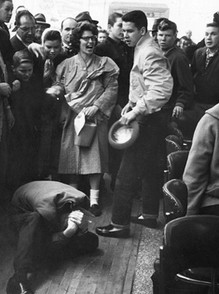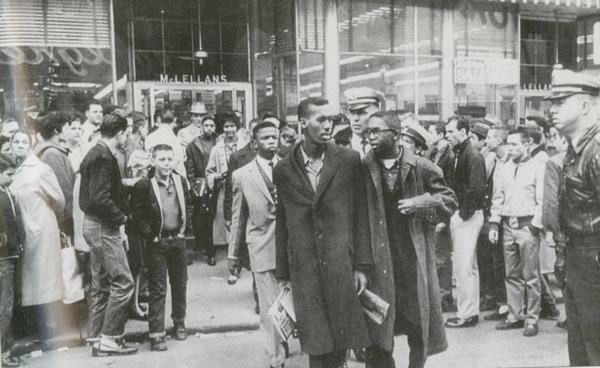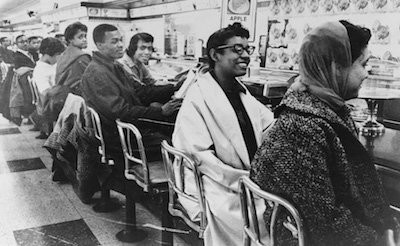Nashville Sit-Ins at Harveys Department Store (1959-1960)
Introduction
Text-to-speech Audio
Images
Four Nashville students including Diane Nash participate in the Nashville sit-ins

White citizens attacked the students on Feb 27, 1960. Police responded by arresting the students even though they offered no resistance, and the police charged them with disorderly conduct

Future Congressman John Lewis was among the student leaders who were arrested on Feb 27, 1960 for protesting against segregation. Lewis would become one of the founding members and chairman of the Student Nonviolent Coordinating Committee (SNCC).

Sit in protesters sitting at the lunch counter.

Harveys grew to include a series of connected buildings facing Church Street and on the east side of 6th Avenue.

Backstory and Context
Text-to-speech Audio
Harveys was a popular local department store in downtown Nashville that opened its doors in 1942. This store was the site selected for the first test of non-violent direct resistance owing to the willingness of Fred Harvey to meet with James Lawson and other Black leaders in the fall of 1959. When Harvey denied Lawson's request to end the color line at his department store's lunch counter, Lawson selected a few students who were willing to enter the store a few weeks later. The November 28, 1959 challenge was not technically a sit-in as the students left immediately after being denied service. However, this small act of resistance served its purpose as both Lawson and the students began formulating their plans for a return visit where the demonstrators would occupy the lunch counter until they were either served or arrested.
Lawson said, “In the fall of 1959, we did some testing of the places downtown in November, a couple weeks of experimental testing. This was to allow people to test themselves, but also for us to find out who was responsible for the decision regarding desegregation and to see how the protesters were treated and, if possible, to talk to the manager or a policy maker in each of the places… We sent them in teams of four to six people.”
African American students met at the Arcade on Fifth Avenue and North in downtown Nashville and split up to protest three nearby shops. The African American students entered three different Nashville establishments known to segregate their diner counters on February 13, 1960, made purchases then proceeded to occupy the segregated lunch counter. The students entered the S.H. Kress Department Store, Woolworths, and the McClellan store, and these establishments had “Whites Only” signs up at their counters; banning African Americans from sitting there. The sit-in protests continued and spread to seven additional shops that were segregated. While the first sit-ins on February 13, 1960, happened without incident, the following protests became violent.
The students involved in the protests were from nearby Black colleges including Fisk University, Tennessee A & I State University, Meharry Medical College, and American Baptist Theological Seminary. These protests inspired other African Americans and activists to protest the segregation of bus terminals, variety stores, department store, and even Walgreen’s drugstores. The non-violent protests were met with white violence and arrests
White citizens converged on the protesters on February 27, 1960, and attacked the Nashville protesters. Consequently, the police arrested 81 of the student protesters and charged them with disorderly conduct. The once non-violent protests turned hostile and violent for the protesters. On April 19, 1960, white supremacists bombed Z. Alexander Looby’s home. Looby was a Black attorney who represented the students who protested. An integrated school was bombed in Nashville, TN three years earlier.
The sit-in protests continued until May 10, 1960, when six of the protested shops agreed to serve all people regardless of race. The protests united many in the Nashville community as many white citizens in the community advocated for unity and desegregation of the city.
The Nashville protests were inspired by the sit-in protest in the Woolworth building in Greensboro, North Carolina on February 1, 1960. Before the Greensboro sit-in, other sit-ins had taken place in St. Louis, Baltimore, Chicago, and fifteen other cities starting in 1943 lasting through 1960 when students protested in Nashville.
Sources
The Kress. Nashville Downtown Partnership. . Accessed October 10, 2018. https://www.nashvilledowntown.com/go/the-kress.
Wynn, Linda T.. Nashville Sit-Ins (1959-1961). TN State. Accessed October 10, 2018. http://ww2.tnstate.edu/library/digital/nash.htm.
Sit-ins: Nashville, Tenn.. Civil Rights Digital Library. . Accessed October 11, 2018. http://crdl.usg.edu/events/sit_ins_nashville_tn/?Welcome&Welcome.
Momodu, Samuel. Nashville Sit-Ins (1960). BlackPast.org. . Accessed October 10, 2018. https://Blackpast.org/aah/nashville-sit-ins-1960.
Nashville Downtown Partnership, Nashville Downtown Partnership, https://www.nashvilledowntown.com/go/the-kress
BlackPast.org, Library of Congress, https://Blackpast.org/aah/nashville-sit-ins-1960.
TN Ledger, Nashville Public Library, Special Collections, April 28, 2017, http://www.tnledger.com/editorial/Article.aspx?id=96698.
Woolworth on Fifth. Nashville Downtown Partnership. .
Accessed October 10, 2018. https://www.nashvilledowntown.com/go/woolworth-on-5th.
Woolworth on 5th. Woolworth on Fifth. . Accessed October 11, 2018. https://woolworthonfifth.com/about/.
Woolworth on 5th. Woolworth on Fifth. . Accessed October 11, 2018. https://woolworthonfifth.com/history/
Morales, Tom, Tuck-Hinton, Tuck-Hinton, http://www.tuckhinton.com/news/180222-woolworthon5th.
Lovett, Bobby L. The Civil Rights Movement in Tennessee. Knoxville, TN. University of Tennessee Press, 2005.
